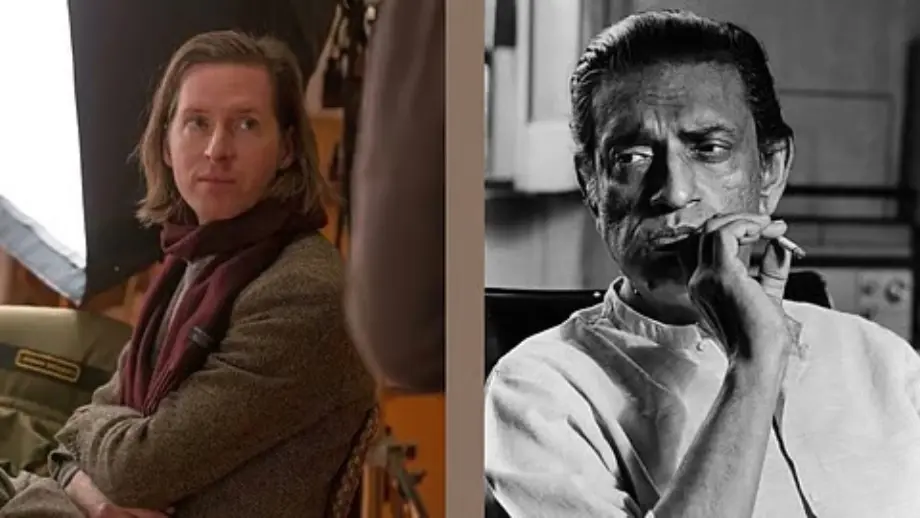Though they hail from different cultures and eras, Satyajit Ray and Wes Anderson share a love for visual symmetry, meticulous framing, and bittersweet storytelling. This piece traces how Ray’s humanism and craft influenced Anderson’s cinematic grammar, offering a quiet dialogue between masters of aesthetic melancholy.
Though they hail from different cultures, continents, and historical contexts, Indian filmmaker Satyajit Ray and Wes Anderson are linked by more than just Wes’ admiration of the Indian filmmaking legend. They are kindred cinematic spirits, bound by a shared affinity for humanism, symmetry, and meticulous visual composition. While Ray carved his legacy as one of India’s most beloved auteurs and a pioneer of global cinema, Anderson, a native Texan with a penchant for obsessive detail, has repeatedly cited Ray as on of his primary influences. Ray’s cinematic grammar echoes through Anderson’s work, bridging decades and oceans in a quirky dialogue between masters of aesthetic melancholy.
Things to do:
- Subscribe to The Hollywood Insider’s YouTube Channel, by clicking here.
- Limited Time Offer – FREE Subscription to The Hollywood Insider
- Click here to read more on The Hollywood Insider’s vision, values and mission statement here – Media has the responsibility to better our world – The Hollywood Insider fully focuses on substance and meaningful entertainment, against gossip and scandal, by combining entertainment, education, and philanthropy.
Satyajit Ray: A Humanist
Born on May 2, 1921, in Kolkata (then Calcutta), Satyajit Ray was a filmmaker, composer, screenwriter, illustrator, and designer. His career catapulted with ‘Pather Panchali’ (1955), the first part of what would become his seminal ‘Apu Trilogy.’ The trilogy follows the life of Apu, from his time as a young boy in rural Bengal, presenting a moving portrait of childhood, family, and modernity. Ray’s films are distinguished by their rich empathy, social realism, and meticulous craftsmanship.
Actors who worked with Ray remember his attention to detail, creative generosity, and complete control over the filmmaking process. Actress Sharmila Tagore once described how Ray operated the camera himself on ‘Days and Nights in the Forest’ (1970) and personally storyboarded every scene, handwriting his scripts and guiding performances down to the smallest gestures. Yet, despite his precision, he maintained an atmosphere of warmth and respect on set.
Ray’s humanist cinema, always infused with melancholy and precision, influenced generations of filmmakers. Beyond his native Bengal, directors such as Martin Scorsese, Akira Kurosawa, and the French New Wave’s François Truffaut praised Ray for his quiet yet radical contributions to global cinematic language. He was the first Indian to receive an Academy Honorary Award in 1992, shortly before his death.
WATCH THE TRAILER of the Film and the Revolution: ‘Can I Go Home Now?’
The Children Around the World Continue to Ask the question
Wes Anderson: The Melancholic Aestheticist
Wes Anderson, born in 1969 in Houston, Texas, is known for his instantly recognizable style, characterized by symmetrical compositions, vibrant color palettes, retro-inspired production design, and characters who teeter between the absurd and the heartbreakingly sincere. His filmography includes ‘The Royal Tenenbaums’ (2001), ‘Moonrise Kingdom’ (2012), ‘The Grand Budapest Hotel’ (2014), and ‘The French Dispatch’ (2021). Although often described as whimsical or twee, Anderson’s work is underpinned by serious themes: grief, abandonment, sibling rivalry, and the aching desire to belong. His characters often embark on journeys, whether physical, emotional, or both, that force them to confront unresolved traumas. These internal transitions are deeply reminiscent of Ray’s narrative philosophy, where characters evolve through intimate, existential trials.
Anderson has repeatedly acknowledged Satyajit Ray’s influence on his cinematic worldview. In interviews, he recalls watching ‘Teen Kanya’ (1961) as a teenager in Texas and being struck by its intimacy and formal beauty. Despite language barriers and poor-quality transfers, Ray’s work reached Anderson deeply. “You can feel his gentleness come through in every frame,” Anderson told The Hollywood Reporter. Anderson’s favorite works include the Calcutta Trilogy (‘The Adversary,’ ‘Company Limited,’ and ‘The Middleman’) and ‘Days and Nights in the Forest,’ with its soulful, flawed heroes. These films’ themes of spiritual aimlessness, societal tension, and emotional isolation strongly resonate in Anderson’s oeuvre.
Related article: – Want GUARANTEED SUCCESS? Remove these ten words from your vocabulary| Transform your life INSTANTLY
Related article: The Unique Artistry of Wes Anderson: A Closer Look at an Auteur – Hollywood Insider

‘The Darjeeling Limited’: An Homage in Motion
The clearest tribute to Ray comes in Anderson’s 2007 film ‘The Darjeeling Limited’. Starring Jason Schwartzman, Owen Wilson, and Adrien Brody as estranged brothers traveling through India by train, the film is explicitly dedicated to Satyajit Ray. The influence is not merely thematic but technical and musical.
The film’s score features several compositions by Ray himself, including pieces from ‘Charulata’ (1964), ‘Teen Kanya’ (1961), ‘Jalsaghar’ (1958), and ‘Joi Baba Felunath’ (1979). Ray, who composed the music for many of his films, imbued his scores with emotional undercurrents that Anderson deftly repurposes. According to Anderson, he spent days in Kolkata waiting for Ray’s foundation to digitize the original master tapes, a process he calls one of the great experiences of his life.
Related article: EVOLUTION: Every Ryan Gosling Role From 1995 to 2020, All Performances Exceptionally Poignant
Related article: EVOLUTION: Every Henry Cavill Role From 2001 to 2021, All Performances Exceptionally Poignant
Related article: The Gilded Cage of Auteurism: Wes Anderson and the Price of Style
Visually, ‘The Darjeeling Limited’ mirrors the poetic pacing and layered storytelling of Ray’s films. The film culminates in a scene where the three brothers chase after a train, their baggage literally and metaphorically abandoned on the platform. It recalls the haunting train-chasing imagery from ‘Pather Panchali’, linking two moments of childhood and adult reckoning across decades.
Yet this homage is not without critique. Some scholars argue that ‘The Darjeeling Limited’ reduces India to an exotic backdrop for Western male transformation. Scenes like the brothers’ visit to a Hindu temple to pray for vague, personal healing can come across as spiritually appropriative. The narrative centers white men in a story set in a culturally rich yet marginalized landscape. Anderson’s intentions may be sincere, but the results are mixed.
Related article: EVOLUTION: Every Ryan Gosling Role From 1995 to 2020, All Performances Exceptionally Poignant
Related article: EVOLUTION: Every Henry Cavill Role From 2001 to 2021, All Performances Exceptionally Poignant
Related article: The Rise & Victory of Mira Nair: The Pride of Indian Representation in Cinema – Hollywood Insider
Echoes in ‘Asteroid City’ and ‘Henry Sugar’
Anderson’s 2023 film ‘Asteroid City’ also nods to ‘Days and Nights in the Forest.’ Both films feature characters engaged in memory games, sitting in circles, and using playful rituals to access deeper truths. The symmetrical framing, deadpan delivery, and philosophical inquiry into isolation, knowledge, and connection recall Ray’s vision of the human condition. His most recent venture, ‘The Phoenician Scheme,’ sees a sporadic and distant father (Benicio del Toro) struggle to reconnect with his children, mirroring the father character of ‘Pather Panchali.’
‘The Wonderful Story of Henry Sugar,’ Anderson’s Oscar-winning 2023 Roald Dahl adaptation, further cements his Indian connection. The story follows a wealthy gambler who discovers the teachings of an Indian mystic, Imdad, who can see without using his eyes. The film’s structure, which mimics a nesting doll of narratives, reflects both Ray’s flair for magical realism and his subtle explorations of greed and spiritual yearning.
Related article: Top 10 South Park Characters | Who Makes the Cut? Kenny, Chef, Butters, Towelie, Eric?
Related article: In-Depth Analysis | The Unexpected Queerness of ‘Bob’s Burgers’: Why the Show is an Animated Ally
Related article: ‘The French Dispatch’: Wes Anderson’s Three-Part Anthology is a Truly Delightful Ode to Journalism – Hollywood Insider
Humanism and Melancholy: A Shared Core
At their best, both Ray and Anderson use style not to distract but to deepen emotional resonance. They are formalists with feelings. Ray’s humanism, most palpable in films like ‘Charulata’ and ‘The Apu Trilogy,’ gives dignity to everyday lives and quiet epiphanies. His characters rarely shout; they drift, hesitate, and weep.
Anderson’s aesthetic, often seen as overly curated, is also a language of containment. In ‘The Royal Tenenbaums,’ ‘Moonrise Kingdom,’ and ‘The French Dispatch,’ characters use eccentricity as armor, only to be slowly unpeeled by grief, regret, or a search for connection. Like Ray, Anderson believes in the redemptive power of human relationships, no matter how fractured.
Family, Disconnection, and Inner Turmoil
Both directors are drawn to dysfunctional families and internal conflict. In Ray’s ‘Charulata,’ a neglected wife finds companionship in her brother-in-law, opening up questions about emotional fidelity and personal aspiration. In ‘The Apu Trilogy,’ familial relationships are tested by poverty, death, and dreams.
Anderson mirrors these concerns in films like ‘The Royal Tenenbaums,’ where a family of former child prodigies reckons with a distant father and a shared history of failure. In ‘The Darjeeling Limited,’ brotherhood is strained by grief and misunderstanding, echoing Ray’s frequent portrayal of relational breakdowns and reunions.
Related article: In-Depth Analysis | The Unexpected Queerness of ‘Bob’s Burgers’: Why the Show is an Animated Ally
Related article: EVOLUTION: Every Chris Evans Role From 1997 to 2020, All Performances Exceptionally Poignant
A Legacy Across Borders
Ray’s influence on Anderson goes beyond musical selections or aesthetic nods. It lives in the quiet spaces between dialogue, the way characters pause before speaking, the yearning glances, the unreconciled endings. Both filmmakers understand that emotional transformation doesn’t always announce itself loudly.
In a media landscape dominated by spectacle and bombast, Ray and Anderson represent something quieter, more considered. Their work reminds us that style can be soulful, and that human connection, fraught, fragile, but vital, is always worthy of our deepest artistic attention.
Ray once said, “The only solutions that are ever worth anything are the solutions that people find themselves.” Anderson, whether knowingly or not, carries that ethos forward. In tracing the emotional blueprints Ray left behind, Anderson converses. And that conversation continues, across time zones, languages, and screens.
Click here to read The Hollywood Insider’s CEO Pritan Ambroase’s love letter to Cinema, TV and Media. An excerpt from the love letter: The Hollywood Insider’s CEO/editor-in-chief Pritan Ambroase affirms, “We have the space and time for all your stories, no matter who/what/where you are. Media/Cinema/TV have a responsibility to better the world and The Hollywood Insider will continue to do so. Talent, diversity and authenticity matter in Cinema/TV, media and storytelling. In fact, I reckon that we should announce “talent-diversity-authenticity-storytelling-Cinema-Oscars-Academy-Awards” as synonyms of each other. We show respect to talent and stories regardless of their skin color, race, gender, sexuality, religion, nationality, etc., thus allowing authenticity into this system just by something as simple as accepting and showing respect to the human species’ factual diversity. We become greater just by respecting and appreciating talent in all its shapes, sizes, and forms. Award winners, which includes nominees, must be chosen on the greatness of their talent ALONE.
I am sure I am speaking for a multitude of Cinema lovers all over the world when I speak of the following sentiments that this medium of art has blessed me with. Cinema taught me about our world, at times in English and at times through the beautiful one-inch bar of subtitles. I learned from the stories in the global movies that we are all alike across all borders. Remember that one of the best symbols of many great civilizations and their prosperity has been the art they have left behind. This art can be in the form of paintings, sculptures, architecture, writings, inventions, etc. For our modern society, Cinema happens to be one of them. Cinema is more than just a form of entertainment, it is an integral part of society. I love the world uniting, be it for Cinema, TV, media, art, fashion, sport, etc. Please keep this going full speed.”
More Interesting Stories From The Hollywood Insider
– Want GUARANTEED SUCCESS? Remove these ten words from your vocabulary| Transform your life INSTANTLY
– A Tribute to Martin Scorsese: A Complete Analysis of the Life and Career of the Man Who Lives and Breathes Cinema
– Do you know the hidden messages in ‘Call Me By Your Name’? Find out behind the scenes facts in the full commentary and In-depth analysis of the cinematic masterpiece
– A Tribute To The Academy Awards: All Best Actor/Actress Speeches From The Beginning Of Oscars 1929-2019 | From Rami Malek, Leonardo DiCaprio To Denzel Washington, Halle Berry & Beyond | From Olivia Colman, Meryl Streep To Bette Davis & Beyond
– In the 32nd Year Of His Career, Keanu Reeves’ Face Continues To Reign After Launching Movies Earning Over $4.3 Billion In Total – “John Wick”, “Toy Story 4”, “Matrix”, And Many More
____________________________________________________________________________









